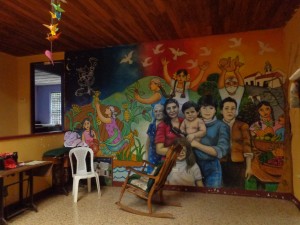On Wednesday, May 14th we visited a non-profit agency in Matagalpa called Casa Materna— an organization that serves and houses primarily rural women who are experiencing high risk pregnancies. Upon entering the agency we were quite impressed with the aesthetic appearance of the building that served as a home to these women. The common areas such as the living room, kitchen, and craft room were fairly large open spaces and were painted with bright attractive colors. The craft room had several different handmade crafts and coloring projects hanging on the wall and the room was also decorated with a beautiful mural that took up a whole large wall. While these physical and aesthetic details may seem somewhat insignificant in the grand scheme of things, it is actually quite impressive and comforting to us as visitors and one would imagine, most likely brings comfort and a sense of “hominess” to the women staying there. Having the place decorated nicely also cultivates a sense of dignity and respect for the residents and displaying their art work and teaching them how to craft gives them something to do and be proud of.

Another thing that stuck out to us, is how difficult it must be for these young girls and women to come to this maternity home while dealing with the stress and complications of having a high risk pregnancy. Not only are they likely frightened and anxious about the health of their babies and their own health, but they also have to leave their homes and family and friends behind for a number of months. While credit and respect is rightly given to the agency for running this organization and providing services to an in-need population, it is equally important to acknowledge the self-sacrifice and courage that it takes these women to make the decision to come to Casa Materna. However, it also makes one realize just how little opportunities and options that women with high risk pregnancies from rural communities have available to them. In many ways, for the sake of the women’s own health and the health of their unborn children, Casa Materna is the only choice available to them. It was also impactful to hear that sexual abuse is quite high in the country overall and also in the rural communities which is what leads to many very young girls having high risk pregnancies.
Overall, we were actually quite impressed with the way the organization runs and the holistic approach that they take by providing multidisciplinary services. It was amazing and inspiring to have heard that the organization was started by members of the community and is also self-sustained by members of the community. It is so impressive to see people come together for a cause and to address their own unique needs like those who work, volunteer, support, and live at Casa Materna.
Crsytal Romine
Stephanie Kiefer
